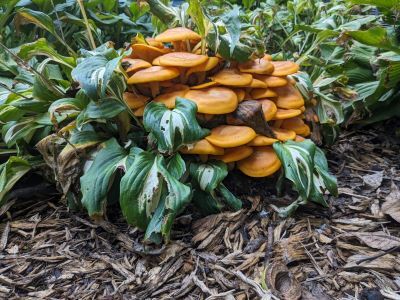
Good Natured: Jack-o'-Lantern Mushroom
With Halloween just around the corner, it seems fitting that we turn our attention to jack-o'-lanterns.
But before you grow misty with memories about the biggest pumpkin you ever carved, or that time the candle almost set the curtain on fire (true story!) let me intervene and gently redirect you toward a completely different, though still appropriately seasonal, jack: Omphalotus illudens, the jack-o'-lantern mushroom.
This fungus grows among us in late summer and fall and this year, thanks to some timely rains and well-dispersed spores, is popping up in places it's never before been seen. Places where hardwood trees, especially oaks, have grown, and died. Places where remnant stumps and roots are barely visible, or buried underground. Places like the yard of Louis Vannatta in Crystal Lake.
Yet when Lou emailed Good Natured World Headquarters a few weeks ago, trees didn't even rate a mention. His correspondence included several photos and a description that read in part, “I have captured something that in all my years I have never seen. Mushrooms invading/overwhelming hostas."
And sure enough, they were. The pictures showed a couple dozen or so convex caps, deep orange in hue, engulfing what had earlier been a healthy hosta with green and white variegated leaves.
The mushroom mass wasn't just large, it also was expanding at a conspicuous rate. “The last 24 hours, it has doubled in volume," Lou noted.
Looking at the photos, I was pretty sure he had a thriving batch of jack-o'-lanterns. The shape and color looked right, and the time of year was spot on too. But fungi aren't exactly one of my things, and I wasn't quite ready to rule out another group of mushroom species, the chanterelles.
Both jacks and chanterelles can have convex caps, and achieve lovely orange hues. But chanterelles don't typically grow in thick clusters; they couldn't overwhelm a hosta if they tried.
Growth habit aside, there were two other key features I was hoping Lou could confirm. One was whether there were gills present on the underside of his mushrooms' caps. Gills are linear structures that radiate out from the stem. They help strengthen the cap and also maximize the surface area where the mushroom's spores, or reproductive cells, are produced.
The underside of a jack-o'-lantern's cap should have gills that extend a little bit down the stem, whereas a chanterelle would display what mycologists call false gills—folds that are forked toward the ends, and not structurally discreet.
I asked Lou if he could pick one of the orange hosta-engulfers and photograph its underside; he obliged, and quickly emailed back. Looking at the photo, it sure seemed like the mushroom had distinct gills, and that they were extending down the stem.
But there was one more trait, one more characteristic—perhaps the best jack-o'-lantern attribute of all—that I really hoped Lou would be game to confirm: Under the right conditions, they are bioluminescent. That is, they glow.
Now we're not talking Vegas Strip brightness here, nor even the shimmering light of a neon beer sign. The greenish light, which emits from the gills and is faint at best, is produced when the organic substance luciferin is oxidized by the action of the enzyme luciferase. (And yes, this is the same chemical reaction that allows fireflies to produce their lights.)
It's the sort of glow that's best viewed in the dark. Make that extreme dark. The sort of dark you can experience only when inside a windowless room, like maybe a garage or crawlspace or closet. You can probably see where this is going…
In an email back to Lou I asked if he might be able to pick a few of his still rapidly expanding mushrooms and take them into one of those very dark spaces. And oh happy day, he was, and he did!
His response after his time in the dark made me chuckle out loud: “Well, never thought I would be holed-up in a broom closet, waiting for my eyes to adjust, but ... There they were, three very faint objects staring back at me. At first one glow, and thought I was imagining things, but the three were properly oriented and I had to believe."
There's one last detail in this jack-o'-lantern tale, and it's one you might find useful should you try to find these fall mushrooms on your own—or if they find you, by popping up in your yard as they did Lou's.
Jack-o'-lanterns are saprobic, which means they feed on dead organic material. Remember how we said they're associated with hardwoods, particularly oaks? Even though it looks like Lou's mushrooms were sprouting from the hostas, in truth they were feeding on, and helping to decompose, the subterranean remains of a 125-year-old red oak tree Lou says had lived in that very spot until it died 10 years ago.
If and when you find jack-o'-lanterns, you might want to think of them as a grave marker of sorts, indicating where a hardwood, perhaps a mighty oak, once grew. That tree might have given up the ghost, but its essence lingers on in the glowing gills of O. illudens.
Happy All Hallows Eve!
Pam Otto is the outreach ambassador for the St. Charles Park District. She can be reached at potto@stcparks.org.

